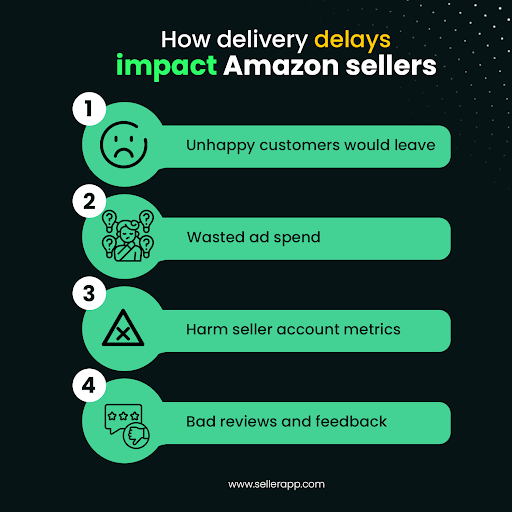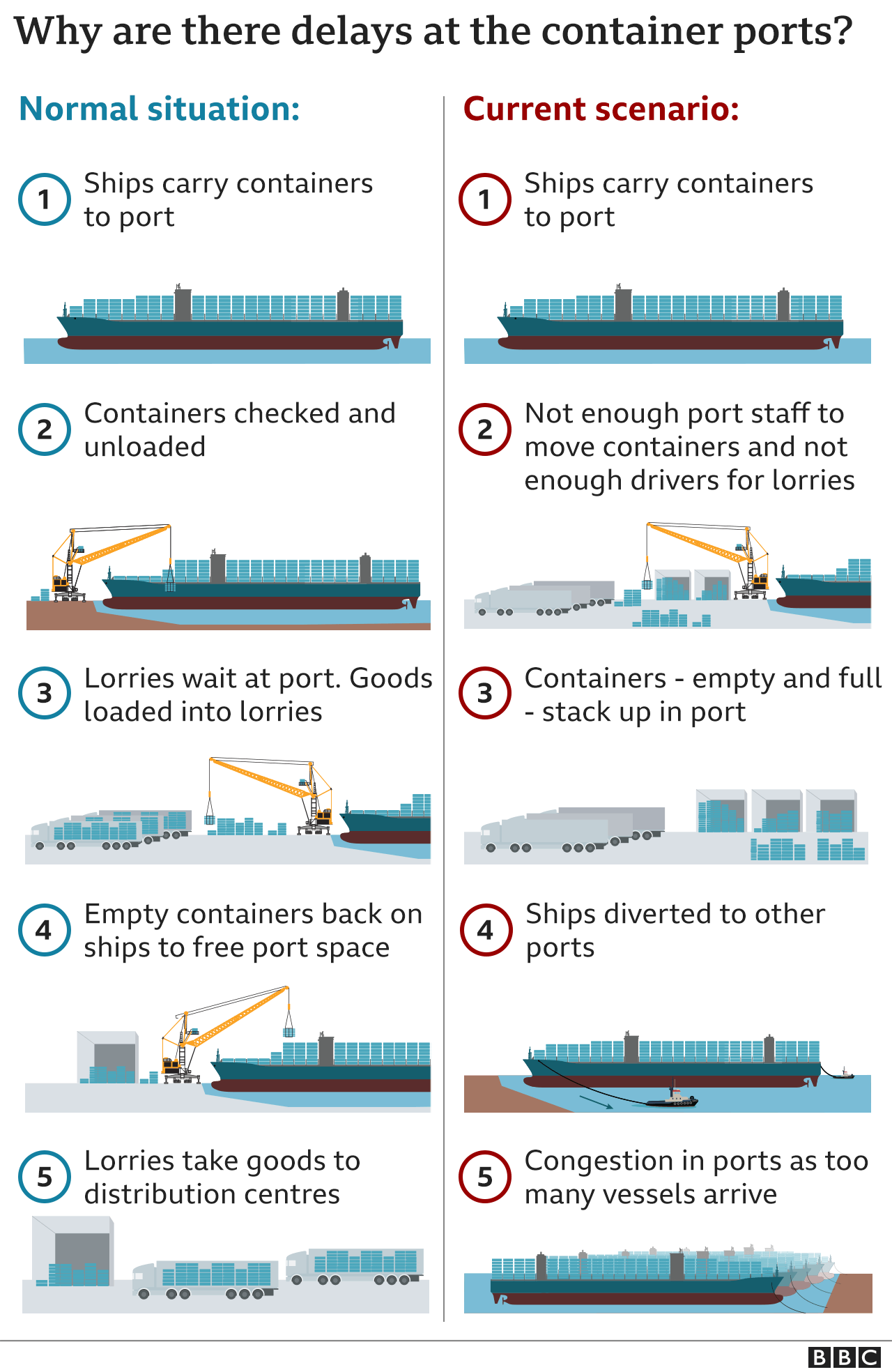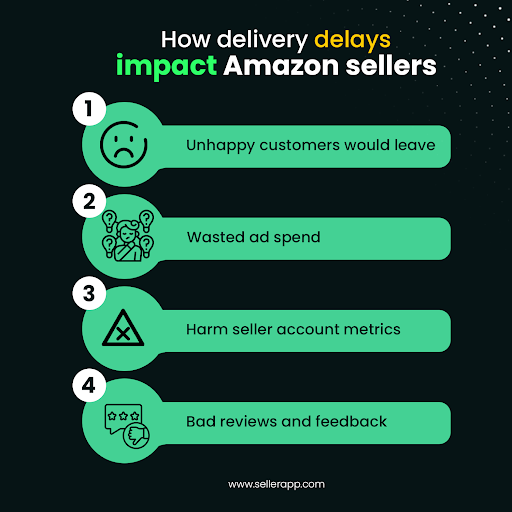Shipping delays have become a frequent concern among online shoppers in the United States. It is crucial for an uninterrupted online shopping experience to comprehend the reasons behind these delays and adopt strategies to deal with them. This all-inclusive guide offers valuable insights, supported by recent data, to assist American consumers in effectively managing shipping delays and minimizing their negative effects on online orders.
The timely delivery of orders is essential for customer satisfaction, loyalty, and retention, as well as for maintaining the positive reputation and profitability of online retailers.
In this blog post, we will delve into the causes and consequences of shipping delays in the United States, and provide advice on how online shoppers can handle them. Additionally, we will share key takeaways and tips to optimize your online shopping experience.

As the e-commerce sector expands, effectively handling shipping delays has become essential for a satisfactory online shopping experience. By adopting these strategies and maintaining realistic expectations, online shoppers in the United States can navigate shipping delays more efficiently and enjoy a smoother online shopping experience. It is important to remember that proactive planning and communication play a crucial role in minimizing the impact of shipping delays on your online orders.
What are the causes of shipping delays in the USA?

Shipping delays can arise from various factors, including weather conditions, natural disasters, labor shortages, customs clearance, peak seasons, and carrier capacity. However, in the United States during 2022 and 2023, one of the primary causes of shipping delays was port congestion.
Port congestion occurs when there is an excess of ships waiting to dock and unload their cargo, exceeding the capacity of the port. This leads to long queues of ships at sea or anchorages, resulting in delayed deliveries and increased expenses.
According to the Bureau of Transportation Statistics (BTS), North American transborder freight experienced a 1.6% decline in September 2023 compared to September 2022. Several major ports in the USA, such as Los Angeles, Long Beach, New York, Charleston, Savannah, Houston, Tacoma, and Mobile, encountered port congestion during 2023.

Multiple factors contributed to the port congestion in the USA, including:
- Increased demand for imported goods from Asia as consumer spending recovered after the pandemic.
- Trade imbalance between Asia and North America, leading to a shortage of empty containers and chassis for transportation.
- Disruptions in global supply chains caused by COVID-19 outbreaks, lockdowns, and travel restrictions in different countries.
- Limited labor availability and reduced productivity at ports due to COVID-19 protocols, safety measures, and health concerns.
- Insufficient capacity and infrastructure at ports to accommodate the growing volume and size of ships.
What are the impacts of shipping delays in the USA?
Shipping delays can have negative impacts on both online shoppers and retailers. Some of these impacts are:

- .
- The impact of shipping delays extends beyond customer dissatisfaction. Here are some additional consequences of shipping delays in the online shopping industry:
- Customer dissatisfaction: Online shoppers may experience frustration, disappointment, or anger when their orders are not delivered on time or as expected. This can lead to a loss of trust in the retailer or carrier and result in customers seeking alternatives or requesting refunds.
- Customer retention: Online shoppers are less likely to make future purchases from a retailer or platform if they consistently encounter shipping delays. They may also share their negative experiences with others through word-of-mouth or social media, further impacting customer retention.
- Revenue loss: Online retailers face potential revenue losses due to canceled orders, refunds, discounts, or compensations offered to dissatisfied customers. Additionally, they may incur higher costs due to storage fees, demurrage charges, or expedited shipping options to mitigate delays.
- Inventory management: Shipping delays can create challenges in managing inventory levels for online retailers. Excessive inventory can tie up cash flow, while insufficient inventory can lead to stockouts or backorders, further affecting sales and customer satisfaction.
- Competitive disadvantage: Online retailers may lose their competitive advantage if they cannot deliver products faster or at competitive prices due to shipping delays. They may also miss out on sales opportunities during peak seasons or promotional events, impacting their market position compared to competitors.
The exponential growth of e-commerce has led to a surge in package deliveries, resulting in increased pressure on logistics networks. According to a report by ShipMatrix, over 3.2 billion packages were delivered in the US during the 2020 holiday season, marking a 13% increase from the previous year (source: ShipMatrix). This surge in volume, coupled with external factors such as extreme weather events and global supply chain disruptions, has contributed to shipping delays across the country.

Strategies for Navigating Shipping Delays:
To mitigate the impact of shipping delays on your online orders, consider the following strategies:
Here are some strategies to effectively manage shipping delays and minimize their impact on your online orders:
- Plan Ahead: Allow extra time for delivery when placing online orders. Consider the estimated shipping times provided by the retailer and factor in additional days to account for any unforeseen delays.
- Track Packages: Stay updated on the progress of your shipments by using tracking services offered by the shipping carrier. Most carriers provide real-time tracking updates through their websites or mobile apps, allowing you to monitor the status and location of your packages.
- Communicate with Retailers: If you encounter significant delays or have concerns about your package, reach out to the retailer’s customer service. They can provide updates on the status of your order or assist in resolving any delivery issues.
- Explore Alternative Delivery Options: Some retailers offer alternative delivery methods, such as in-store pickup or locker services, which can help bypass potential shipping delays. Additionally, you may have the option to choose expedited shipping methods that prioritize faster delivery.
- Manage Expectations: Understand that shipping delays can occur due to external factors beyond the retailer’s control, such as weather events or global disruptions. It’s important to have patience and understanding while navigating shipping delays.
By implementing these strategies and maintaining realistic expectations, you can navigate shipping delays more effectively and ensure a smoother online shopping experience.
Tips for Navigating Shipping Delays
Quick Takeaways:
- Plan ahead and allow extra time for delivery to account for potential delays.
- Utilize tracking services provided by shipping carriers to stay informed about the progress of your shipments.
- Communicate with retailers for updates and consider alternative delivery options to bypass delays when available.
- Port congestion is one of the main causes of shipping delays in the USA in 2022 and 2023, due to the surge in demand for imported goods, the imbalance of trade, the disruption of supply chains, the lack of labor and capacity at ports, and other factors.
- Shipping delays can have negative impacts on customer satisfaction, loyalty, retention, revenue, inventory, and competitive advantage for online retailers.
- Online shoppers can cope with shipping delays by planning ahead, being flexible, communicating, and being understanding.
We hope this blog post has helped you learn more about shipping delays in the USA and how to navigate them as an online shopper. If you have any comments or feedback, please feel free to share them with us. Happy shopping!
Title: Shipping Delays: Navigating Shipping Delays for Online Shoppers in the USA
Keywords: US online shopping, shipping delays, package delivery, logistics, online order delays
Shipping Delays: Navigating Shipping Delays for Online Shoppers in the USA
Shipping delays have become a common concern for online shoppers in the USA. Understanding the causes of delays and implementing strategies to navigate them is crucial for a seamless online shopping experience. This comprehensive guide provides valuable insights, backed by recent data, to help US consumers effectively manage shipping delays and minimize their impact on online orders.
Shipping delays can affect customer satisfaction, loyalty, and retention, as well as the reputation and profitability of online retailers.
In this blog post, we will explore some of the causes and impacts of shipping delays in the USA, and how online shoppers can cope with them. We will also provide some quick takeaways and tips to help you make the most of your online shopping experience.

As the e-commerce industry continues to grow, managing shipping delays has become an integral part of the online shopping experience. By implementing these strategies and maintaining realistic expectations, US online shoppers can navigate shipping delays more effectively and ensure a smoother online shopping experience. Remember, proactive planning and communication are key to mitigating the impact of shipping delays on your online orders.
What are the causes of shipping delays in the USA?

Shipping delays can occur due to various factors, such as weather conditions, natural disasters, labor shortages, customs clearance, peak seasons, and carrier capacity. However, one of the main causes of shipping delays in the USA in 2022 and 2023 has been port congestion.
Port congestion is a situation where there are more ships waiting to dock and unload their cargo than the port can handle. This leads to long queues of ships at sea or at anchorages, resulting in delayed deliveries and increased costs.
According to the Bureau of Transportation Statistics (BTS), North American transborder freight was down 1.6% in September 2023 from September 2022. Some of the major ports in the USA that experienced port congestion in 2023 were Los Angeles, Long Beach, New York, Charleston, Savannah, Houston, Tacoma, and Mobile.

The port congestion in the USA was caused by several factors, such as:
– The surge in demand for imported goods from Asia due to the recovery of consumer spending after the pandemic.
– The imbalance of trade between Asia and North America, resulting in a shortage of empty containers and chassis to transport them.
– The disruption of global supply chains due to COVID-19 outbreaks, lockdowns, and travel restrictions in various countries.
– The lack of labor availability and productivity at ports due to COVID-19 protocols, safety measures, and health issues.
– The limited capacity and infrastructure of ports to handle the increasing volume and size of ships.
What are the impacts of shipping delays in the USA?
Shipping delays can have negative impacts on both online shoppers and retailers. Some of these impacts are:

- Customer dissatisfaction: Online shoppers may feel frustrated, disappointed, or angry when their orders do not arrive on time or as expected. They may also lose trust in the retailer or the carrier and seek alternative options or refunds.
- Customer retention: Online shoppers may be less likely to shop again from the same retailer or platform if they experience frequent or severe shipping delays. They may also share their negative experiences with others through word-of-mouth or social media reviews.
- Revenue loss: Online retailers may lose revenue due to canceled orders, refunds, discounts, or compensations offered to dissatisfied customers. They may also incur higher costs due to storage fees, demurrage charges, or expedited shipping options.
- Inventory management: Online retailers may face challenges in managing their inventory levels due to shipping delays. They may have excess inventory that ties up their cash flow or insufficient inventory that leads to stockouts or backorders.
- Competitive advantage: Online retailers may lose their competitive edge over their rivals if they cannot deliver their products faster or cheaper. They may also miss out on sales opportunities during peak seasons or promotional events.
The exponential growth of e-commerce has led to a surge in package deliveries, resulting in increased pressure on logistics networks. According to a report by ShipMatrix, over 3.2 billion packages were delivered in the US during the 2020 holiday season, marking a 13% increase from the previous year (source: ShipMatrix). This surge in volume, coupled with external factors such as extreme weather events and global supply chain disruptions, has contributed to shipping delays across the country.

Strategies for Navigating Shipping Delays:
To mitigate the impact of shipping delays on your online orders, consider the following strategies:
1. Plan Ahead: When placing online orders, account for potential delays by allowing extra time for delivery. Consider the estimated shipping times provided by the retailer and factor in additional days to accommodate any unforeseen delays.
2. Track Packages: Stay informed about the progress of your shipments by utilizing tracking services provided by the shipping carrier. Most carriers offer real-time tracking updates through their websites or mobile apps, allowing you to monitor the status and location of your packages.
3. Communicate with Retailers: If you experience significant delays or have concerns about your package, reach out to the retailer’s customer service. They can provide you with updates on the status of your order or assist in resolving any delivery issues.
4. Consider Alternative Delivery Options: Some retailers offer alternative delivery methods, such as in-store pickup or locker services, which can help bypass potential shipping delays. Additionally, you may have the option to choose expedited shipping methods that prioritize faster delivery.
5. Managing Expectations: While shipping delays can be frustrating, it’s important to manage your expectations and be aware of the current challenges faced by the logistics industry. Recognize that external factors, such as weather events and global disruptions, are beyond the retailer’s control. Patience and understanding can go a long way in navigating shipping delays.
Tips for Navigating Shipping Delays
- Communication: Retailers should proactively communicate with customers, explaining the reasons for delays and providing estimated delivery times.
- Free Shipping: Offering free shipping can help manage customer expectations for faster delivery.
- Alternative Shipping Options: Explore alternative shipping options or couriers to mitigate delays.
- Order Tracking: Provide customers with accurate and real-time tracking information to keep them informed about their package’s status.
- Customer Support: Offer responsive customer support to address any concerns or issues related to shipping delays.
Quick Takeaways:
- Shipping delays are a common concern for US online shoppers due to increased package volumes and external factors.
- Plan ahead and allow extra time for delivery to account for potential delays.
- Utilize tracking services provided by shipping carriers to stay informed about the progress of your shipments.
- Communicate with retailers for updates and consider alternative delivery options to bypass delays when available.
- Port congestion is one of the main causes of shipping delays in the USA in 2022 and 2023, due to the surge in demand for imported goods, the imbalance of trade, the disruption of supply chains, the lack of labor and capacity at ports, and other factors.
- Shipping delays can have negative impacts on customer satisfaction, loyalty, retention, revenue, inventory, and competitive advantage for online retailers.
- Online shoppers can cope with shipping delays by planning ahead, being flexible, communicating, and being understanding.
We hope this blog post has helped you learn more about shipping delays in the USA and how to navigate them as an online shopper. If you have any comments or feedback, please feel free to share them with us. Happy shopping!

